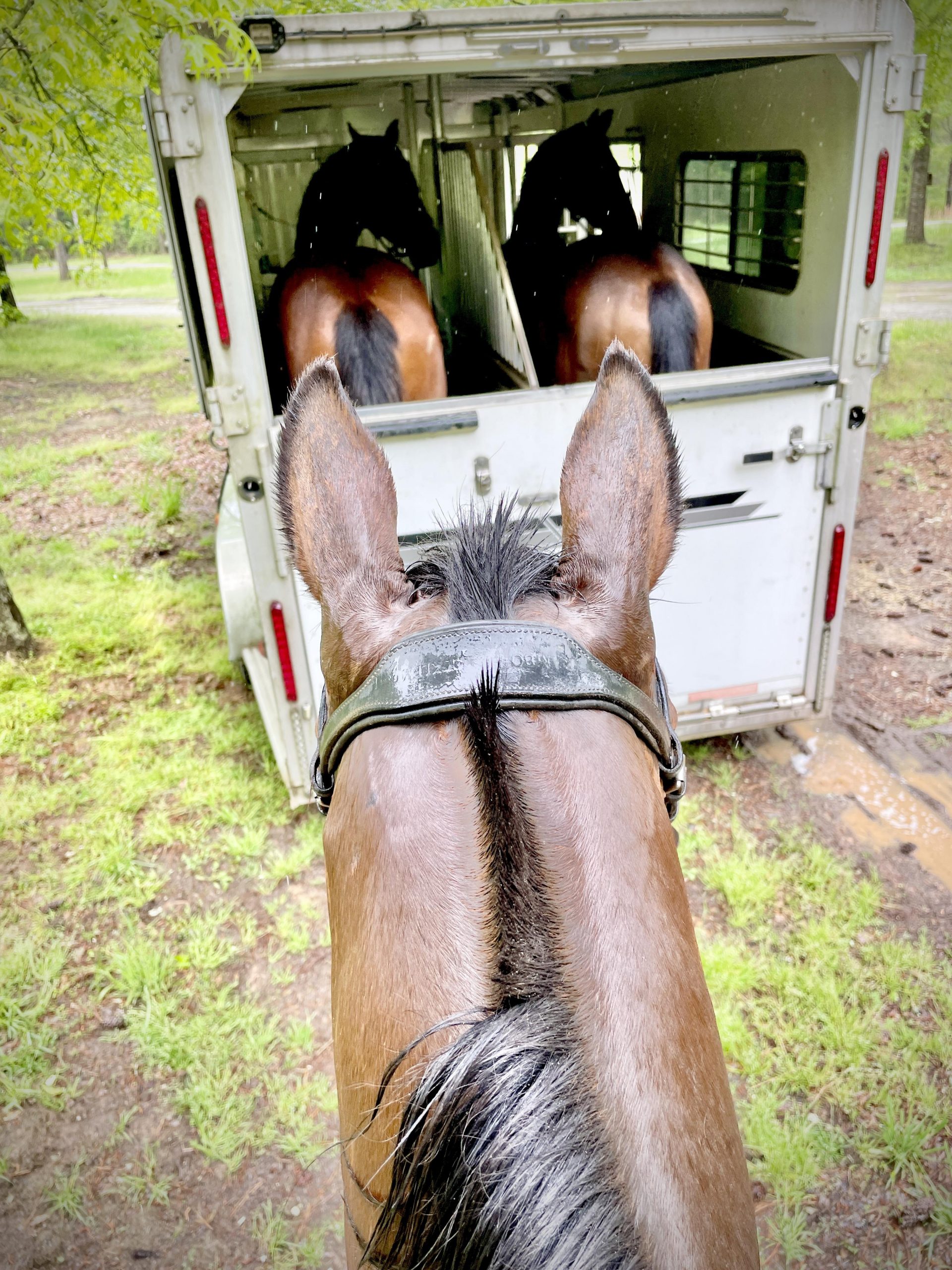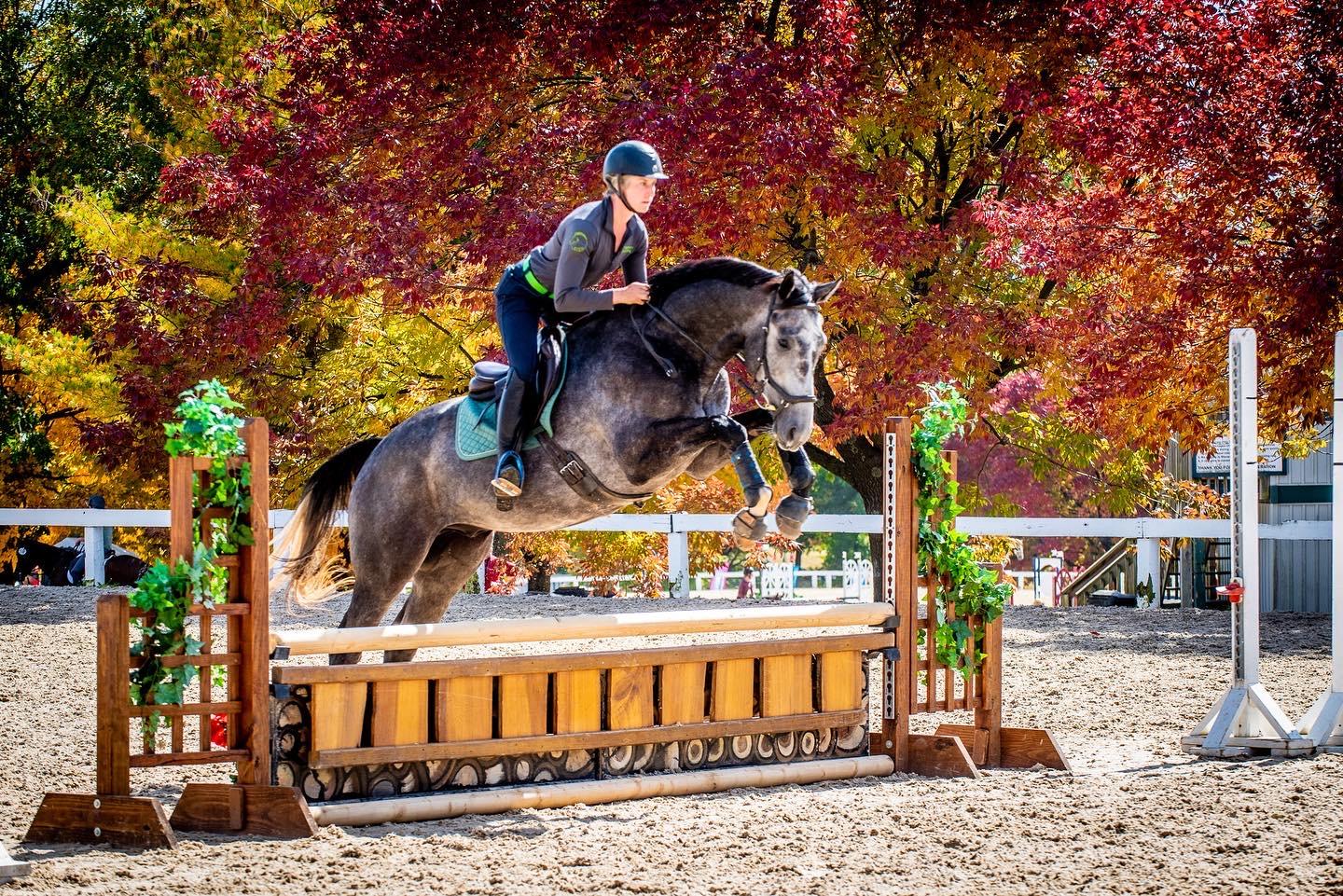
Thoroughbred Logic: Go Cross Country School
“You are never truly ready, and there are always excuses or more training that ought to be done. In my books, do you have semi-OK brakes? Do you have semi-OK forward and semi-OK steering? Fantastic, off to cross country for you. Feeling not ready? Meh, do it anyway.”
Welcome to the next installment of Thoroughbred Logic. In this weekly series, Anthropologist and trainer Aubrey Graham, of Kivu Sport Horses, offers insight and training experience when it comes to working with Thoroughbreds (although much will apply to all breeds). This week, come along for the ride as Aubrey offers her logic on the importance of getting out and schooling cross country — whether or not you think you’re ready.
This spring has felt a bit like my horses and I need four wheel drive. Yes, my truck certainly has it, but no, what I’m saying is that I need it. The mud has been literal and figurative. And between lost shoes, small injuries, track soreness, and other random issues, it has been one foot forward and then not any back. Nope, no backtracking. Rather it has felt like progress happens and then one gets stuck with that foot forward in the sucking, thick kind of mud that will take your boot — or their shoes — off.
The recent one-step-forward-then-mired has not quite had the same effect as the winter slow down. No, that was needed. This is frustrating. So when it rained for a good portion of the week (again), and my arena became a swimming pool (again), I gave up and got creative and packed the trailer. Friday and Saturday (and then a clinic on Sunday) saw my young horses testing out the not-as-soggy-as-one-would-expect cross country course at Ashland Farm. I might only have a three horse rig and might only have managed to get six horses schooled before teaching a clinic there on Sunday, but that was progress. And those couple steps forward (without the stuck-ness) felt so needed.

Looking through Wolf’s (Louisiana Moon) ears in the rain at Ashland Farm. Rhodie (Western Ridge) and Needles Highway hung out on the rig while we schooled in the pouring rain. Good boy, Wolf. Photo by author.
Getting young horses out on cross country for the first time can be nerve wracking. And more often than not, the sheer idea of doing so stops folks in their tracks and makes them say things like, “We’ll get out XC when they are quiet off property” or “We’re only jumping crossrails, we’re not ready for solid fences quite yet,” or the more general “We’ll get there when we are ready.”
For those who have been reading this article series for a while, you know what is coming next. You are never truly ready, and there are always excuses or more training that ought to be done. In my books, do you have semi-OK brakes? Do you have semi-OK forward and semi-OK steering? Fantastic, off to cross country for you. Feeling not ready? Meh, do it anyway.

Ellie (Lady Allyn) got to join in the XC schooling fun on Saturday. This new-to-jumping mare hacked all over like a pro, hopped logs and small rolltops and was a very very good kid. Photo by Alanah Giltmier.
There are so many benefits to getting out on a cross country field even when you think you’re not quite ready. Here are a few:
Getting a horse off property in general — especially a green Thoroughbred — only makes them better. The Retired Racehorse Project folks have been emphasizing this training component for years. And it shows when folks arrive at the Kentucky Horse Park for the annual Thoroughbred Makeover. The more seasoned the horse is at taking it all in, the better they do in the big atmosphere of that show. But even if one’s horse isn’t gearing up for the Makeover, gaining that experience early on does such amazing things, it is always worth it, even if it is not perfect, and even if you 100% don’t feel ready.

Tuck (Louisiana Bling) took everything in stride at the 2022 Thoroughbred Makeover after having been off property a good number of times before arriving. Photo by Lauren Schuster.
On one hand, getting out and about (and particularly) on cross country builds trust. And that works both ways. There is plenty out there that might be jarring to a young horse, but presented calmly and overcome well, those experiences add up to, “Oh hey, maybe this person on my back isn’t really trying to set me up for certain death.” And a horse that is pretty sure you’re there to have fun as a team, and not to murder them with the brush, the water, the bench jump or the ditch, is a horse who is more willing to flick an ear to you and check in when they are unsure.

Needles Highway thought the water might kill him for about 30-seconds. Then once in, he lit up and enjoyed the splashing. Photo by author.
Equally, as mentioned in an article a couple weeks back, the more you know that your horse is going to think and respond instead of just reacting, the more you can trust them, the more they feel secure, and the positive cycle rolls on… well, positively.
On the other hand, in terms of training, getting out cross country also has stellar benefits. I’m pretty sure that for most horses arenas can become exhausting and boring… especially for horses accustomed to the excitement of the race and the big sweeping turns of the track. Small circles ad nauseam can make them dull, if not also eventually sour. The wide open of the field might be daunting, but more often than not, as these horses get out there, they figure it out. Their ears stay permanently forward. It is fun. And when challenges are approached in a space of play, they are often received ridiculously well.
I love watching them start to figure out it. You walk a little log, then trot another smaller log, then you point them at the medium log, the ears go up, and they go, “Hell yeah, I’ve got this.” That methodical, enthusiastic progression not only contributes to the production of versatile, happy horses, but it also gives you a foundation to translate back to the arena.
In that progression, they’re not just figuring out cross country, they’re figuring out the whole concept of jumping. The way horse’s brains and eyes work, it is always so much easier to conceptualize what their body is supposed to do over a solid round object, than over a set of arbitrarily elevated poles. And so in the process of those tiny rolltops and fallen trees, they learn to lift their shoulder, use their neck for balance, and conceptualize footwork on the takeoff and landing. Inevitably, when I’m out schooling a green horse on cross country, I end up with this sh*t-eating grin on my face as I feel them figure out it. In a 30-minute school, you can witness a horse go from insecure frog/deer jumps to confident approaches with significantly improved form.
Curry (Curlin Lane) and Wolf (Louisiana Moon) both tested and proved this concept the other day. Both have less than 10 post-track rides with minimal experience over small cross-rails in the arena. Their form was questionable, though I never worry about this to start as this comes with time and confidence (I’ll get to this in another article soon). Out on cross country, they did the standard: walk the things to trot the things to try a canter over things here or there. Both horses met the challenges bravely, figured their jump out and by the end, began to think about their footing, placement, arc and push. And, for having gone through the water, walked the ditches and banks, and popped over the small solid jumps, both just-off-track horses are braver, more confident, and more prepared to address challenges in the arena as much as out of it.
In the process of cross country schooling green horses (especially Thoroughbreds) for the first time, though, there are a couple of “hacks” that make it all a lot less stressful.
- Give up on the walk initially: If you enter the field and they want to jig or go — let them move, but in a controlled manner. A walk will rarely calm a Thoroughbred. I always joke that if their feet are moving, their brain is working — so go trot safely around the elements and let them settle in. Once they want to walk, it becomes a reward. And from there you can move on to then walking some of the elements on soft contact.
- Also, depending on the horse and their level of excitement or stress, I will avoid the canter until I am landing off of fences. There is no point amping a horse up at a gallop in a big open field, only to then ask them to come back quietly and think about walking and slowly trotting logs. Nope, I leave the canter-in-field for the landing.
- And finally, be willing to be done when they are successful. Yes, cross country schooling is a treat for horses and humans. Often, it is also something we have to haul to, pay for and absolutely want to make the most of. That said, when your horse has successfully done a few things, taken a breath and enjoyed the challenge, call it a day. If you’re not quite ready to hop off, head out for a hack or a trail ride. That level of self restraint is hard to do, but pushing it or keeping them out there too long can start to unravel that positive balance.
Hell, Rhodie needed to school drops into water the other day. I haven’t had him on cross country in a minute, but when he got the footwork right on the little log-to-water-drop, I had to stop, pat him and call it day. I really, really wanted to give the bigger log-to-water-drop a shot, But live to train and tackle that bigger fence another day.
Overall though, each horse is going to handle the field and the fences a bit differently. But, if you take it slow, make it fun, and ensure that you’re approaching it for experience not perfection, that first school is usually a rousing success. So go toss them on the trailer and bring on the new experiences. They’ll thank you later.









